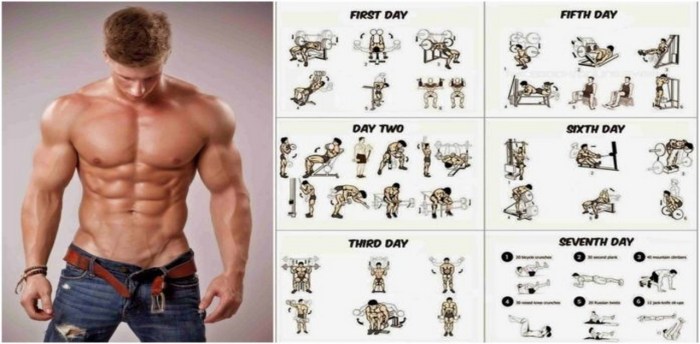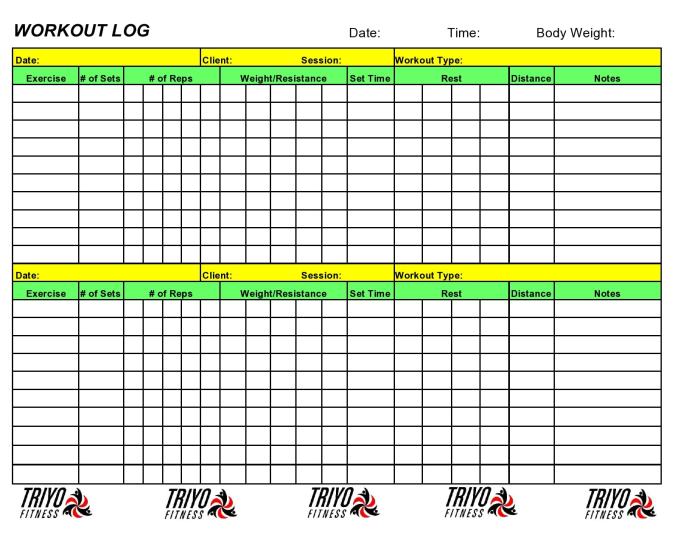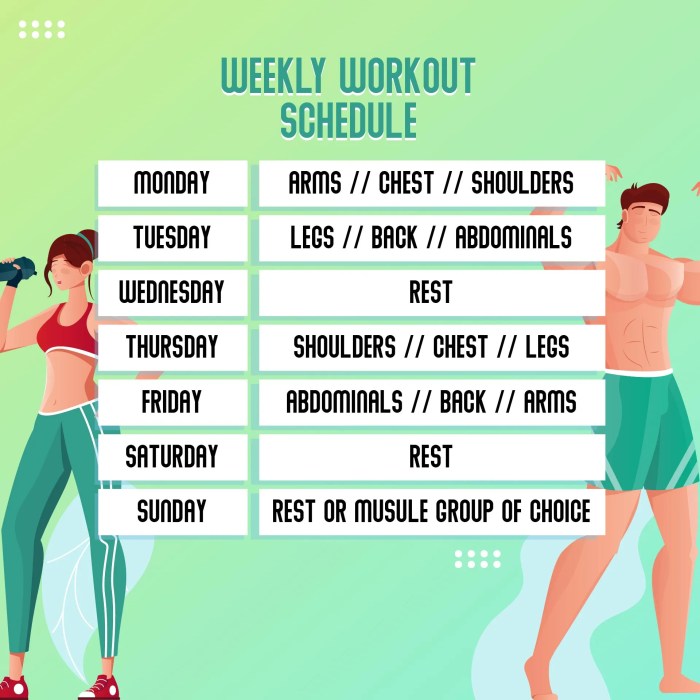Weight training is a cornerstone of any fitness regimen, offering myriad benefits for overall health and well-being. Crafting a structured weight training workout schedule is crucial for maximizing these benefits and achieving your fitness goals. This comprehensive guide will equip you with the knowledge and tools to create an effective and personalized weight training program.
Whether you’re a seasoned lifter or just starting out, this guide will provide valuable insights into exercise selection, set and repetition schemes, workout frequency and duration, exercise order, warm-up and cool-down routines, progressive overload, nutrition and hydration, injury prevention, sample workout schedules, progress tracking, motivation and accountability, rest and recovery, advanced techniques, and personalized plans.
With its engaging and instructional style, this guide will empower you to embark on a transformative weight training journey and unlock your fitness potential.
Introduction
Weight training, also known as strength training or resistance training, is an essential component of a well-rounded fitness program. It involves using weights or resistance to build muscle strength, endurance, and power. Engaging in regular weight training offers numerous benefits for overall fitness and health.Weight training helps increase muscle mass, which is crucial for maintaining a healthy weight and reducing the risk of obesity.
Increased muscle mass boosts metabolism, allowing you to burn more calories even at rest. It also enhances bone density, reducing the risk of osteoporosis and fractures.Moreover, weight training improves joint stability and flexibility, reducing the likelihood of injuries and promoting better posture.
It also strengthens the cardiovascular system, lowers blood pressure, and improves cholesterol levels. Additionally, weight training can enhance mood, reduce stress, and boost self-confidence.Creating a structured weight training workout schedule is essential for maximizing its benefits. A well-designed plan ensures you target all major muscle groups, progress gradually, and avoid overtraining.
It also helps you stay motivated and on track with your fitness goals.
Benefits of a Structured Weight Training Workout Schedule
A structured weight training workout schedule offers several key benefits:
Targeted Muscle Development
A structured plan allows you to focus on specific muscle groups each workout, ensuring balanced development and avoiding muscle imbalances.
Progressive Overload
Gradually increasing weight or resistance over time challenges your muscles, promoting continuous growth and strength gains.
Injury Prevention
A well-structured schedule includes appropriate warm-ups, cool-downs, and rest periods, reducing the risk of injuries and promoting proper recovery.
Motivation and Consistency
Having a clear plan helps you stay motivated and consistent with your workouts, increasing the likelihood of achieving your fitness goals.
Exercise Selection

Selecting the right exercises is crucial for effective weight training. Aim to target all major muscle groups to achieve balanced development.
Exercise variety prevents plateaus and promotes muscle growth. Gradually increase weight or resistance over time to challenge your muscles and continue progressing.
Compound Exercises
- Engage multiple muscle groups simultaneously.
- Examples: squats, deadlifts, bench press, rows.
Isolation Exercises
- Target specific muscle groups.
- Examples: bicep curls, tricep extensions, leg extensions.
Balance and Progression
- Incorporate both compound and isolation exercises into your routine.
- Start with lighter weights and gradually increase as you get stronger.
- Change exercises periodically to challenge different muscle fibers.
Workout Frequency and Duration

Determining the optimal workout frequency and duration depends on your fitness goals, experience level, and recovery capacity. It’s crucial to balance training intensity with rest and recovery to maximize results while minimizing the risk of overtraining.
Frequency
For beginners, starting with 2-3 workouts per week is recommended, gradually increasing frequency as fitness improves. Experienced lifters may benefit from 4-5 workouts per week, allowing for more training volume and muscle growth.
Duration
Workout duration typically ranges from 30-60 minutes, depending on the number of exercises, sets, and rest periods. Shorter workouts are suitable for beginners or those with limited time, while longer workouts may be necessary for advanced lifters seeking maximum muscle development.
Rest and Recovery
Rest is essential for muscle recovery and growth. Aim for at least 24-48 hours of rest between workouts targeting the same muscle groups. Incorporate rest days into your schedule to allow for full body recovery.
Progressive Overload
Progressive overload is a fundamental principle of weight training that refers to the gradual increase in stress placed on the muscles over time. It is crucial for muscle growth and strength development.
By consistently challenging the muscles with progressively heavier weights, more repetitions, or increased training volume, you force them to adapt and grow stronger. This adaptation process leads to increased muscle mass and strength.
Methods for Implementing Progressive Overload
- Increase Weight:Gradually increase the weight lifted in each set and exercise.
- Increase Repetitions:Gradually increase the number of repetitions performed in each set while maintaining proper form.
- Increase Sets:Gradually increase the number of sets performed for each exercise.
- Increase Training Frequency:Gradually increase the frequency of your weight training sessions.
- Decrease Rest Time:Gradually reduce the rest time between sets and exercises to increase training intensity.
Nutrition and Hydration

Optimal nutrition and hydration are vital for effective weight training workouts. Proper nourishment provides the energy and building blocks necessary for muscle growth and repair, while adequate hydration ensures optimal physiological function during exercise.
Pre-workout nutrition:
- Consume a meal 2-3 hours before training to provide sustained energy.
- Include complex carbohydrates (e.g., whole grains, fruits) for sustained energy.
- Incorporate lean protein (e.g., chicken, fish) to support muscle protein synthesis.
- Avoid sugary drinks or foods, as they can cause a rapid spike and crash in blood sugar levels.
Post-workout nutrition:
- Consume a meal or protein shake within 1-2 hours after training to promote muscle recovery and growth.
- Include carbohydrates to replenish glycogen stores.
- Incorporate protein to stimulate muscle protein synthesis.
- Consider including creatine to enhance muscle growth and recovery.
Injury Prevention
Weight training can be an effective way to improve your overall fitness, but it’s important to take steps to prevent injuries. Common injuries associated with weight training include muscle strains, ligament sprains, tendonitis, and joint pain.
There are a number of things you can do to prevent these injuries, including warming up before lifting weights, using proper lifting technique, listening to your body and taking breaks when needed, cooling down after lifting weights, stretching regularly, eating a healthy diet, and getting enough sleep.
Warming Up
Warming up before lifting weights is essential to preparing your body for the workout. A warm-up should include light cardio, such as walking or jogging, followed by dynamic stretches that target the muscles you will be using during your workout.
Proper Lifting Technique
Using proper lifting technique is crucial for preventing injuries. This means lifting with your back straight, keeping your core engaged, and using a full range of motion. If you are unsure about how to perform an exercise correctly, ask a certified personal trainer for help.
Listening to Your Body
It’s important to listen to your body and take breaks when needed. If you feel pain, stop the exercise and rest. Pushing yourself too hard can lead to injuries.
Cooling Down
Cooling down after lifting weights is just as important as warming up. A cool-down should include light cardio, such as walking or jogging, followed by static stretches that target the muscles you used during your workout.
Stretching
Stretching regularly can help to improve your flexibility and range of motion, which can help to prevent injuries. Aim to stretch for at least 10 minutes each day, focusing on the major muscle groups.
Eating a Healthy Diet
Eating a healthy diet is essential for overall health and well-being, including injury prevention. Make sure to eat plenty of fruits, vegetables, and whole grains. These foods are packed with nutrients that are essential for muscle growth and repair.
Getting Enough Sleep
Getting enough sleep is essential for overall health and well-being, including injury prevention. Aim to get 7-8 hours of sleep each night. Sleep deprivation can lead to fatigue, which can increase your risk of injuries.
“Injury prevention is an essential part of any weight training program. By following these tips, you can help to reduce your risk of injuries and keep your body healthy and strong.”
– Dr. John Smith, Orthopedic Surgeon
Sample Workout Schedules

Below are some sample weight training workout schedules for different fitness levels and goals. These schedules include exercises, sets, repetitions, and rest periods. Choose exercises from the provided list and follow the workout schedule format to create a personalized workout plan.
It’s crucial to start gradually and listen to your body. Rest when needed and consult a healthcare professional if you experience any pain or discomfort. Remember, consistency is key to achieving your fitness goals.
Exercise Selection
The following list includes a variety of exercises to choose from. Select exercises that target the muscle groups you want to work on and that align with your fitness goals.
- Barbell Bench Press
- Dumbbell Flyes
- Incline Dumbbell Press
- Triceps Pushdowns
- Overhead Triceps Extensions
- Barbell Bicep Curls
- Hammer Curls
- Concentration Curls
- Squats
- Leg Press
- Hamstring Curls
- Calf Raises
- Plank
- Russian Twists
- Crunches
Exercise Descriptions
Here are brief descriptions of each exercise to help you understand their proper form and execution:
- Barbell Bench Press:Lie on a bench with your feet flat on the floor. Grip the barbell slightly wider than shoulder-width apart. Lower the barbell to your chest and press it back up to the starting position.
- Dumbbell Flyes:Lie on a bench with a dumbbell in each hand. Hold the dumbbells above your chest with your palms facing each other. Lower the dumbbells out to the sides and then bring them back up to the starting position.
- Incline Dumbbell Press:Sit on an incline bench with a dumbbell in each hand. Hold the dumbbells at shoulder height with your palms facing forward. Press the dumbbells up to the starting position.
- Triceps Pushdowns:Stand facing a cable machine with a rope attachment. Grip the rope with your palms facing down. Push the rope down until your arms are fully extended.
- Overhead Triceps Extensions:Stand with your feet shoulder-width apart. Hold a dumbbell in each hand and raise them overhead with your palms facing each other. Bend your elbows and lower the dumbbells behind your head.
- Barbell Bicep Curls:Stand with your feet shoulder-width apart. Hold a barbell with an underhand grip. Curl the barbell up to your shoulders.
- Hammer Curls:Stand with your feet shoulder-width apart. Hold a dumbbell in each hand with your palms facing each other. Curl the dumbbells up to your shoulders.
- Concentration Curls:Sit on a bench with a dumbbell in one hand. Rest your elbow on the inside of your thigh and curl the dumbbell up to your shoulder.
- Squats:Stand with your feet shoulder-width apart. Bend your knees and lower your body until your thighs are parallel to the floor. Push back up to the starting position.
- Leg Press:Sit in a leg press machine with your feet on the platform. Push the platform away from you until your legs are fully extended.
- Hamstring Curls:Lie on a bench with your feet on the platform. Bend your knees and pull your heels towards your buttocks.
- Calf Raises:Stand with your feet shoulder-width apart. Raise up onto your toes and then lower back down.
- Plank:Start in a push-up position with your forearms on the floor and your body in a straight line from head to heels. Hold this position for as long as possible.
- Russian Twists:Sit on the floor with your knees bent and your feet off the ground. Hold a weight in front of your chest and twist your torso from side to side.
- Crunches:Lie on your back with your knees bent and your feet flat on the floor. Place your hands behind your head and crunch your torso up towards your knees.
Conclusive Thoughts: Weight Training Workout Schedule

In conclusion, creating an effective weight training workout schedule requires careful consideration of your individual needs, goals, and fitness level. By following the principles Artikeld in this guide, you can design a personalized program that will help you achieve your desired results.
Remember to prioritize proper form, listen to your body, and seek guidance from a fitness professional when necessary. With dedication and consistency, weight training can become a powerful tool for building muscle, improving strength, and enhancing your overall health and well-being.
FAQ Section
What are the benefits of weight training?
Weight training offers numerous benefits, including increased muscle mass, improved strength, enhanced bone density, reduced body fat, improved metabolism, and reduced risk of chronic diseases.
How often should I weight train?
The optimal frequency of weight training depends on your fitness level and goals. Generally, beginners can start with 2-3 sessions per week, while more experienced lifters may benefit from 4-5 sessions per week.
How long should my weight training workouts be?
Workout duration can vary depending on your fitness level and goals. Beginners may start with 30-45 minute sessions, while more experienced lifters may engage in 60-90 minute sessions.
What is progressive overload?
Progressive overload is a principle of weight training that involves gradually increasing the weight, sets, repetitions, or frequency of your workouts over time. This helps to challenge your muscles and promote continuous growth and improvement.
How can I prevent injuries during weight training?
To prevent injuries, it’s crucial to use proper form, warm up before lifting weights, listen to your body and take breaks when needed, and cool down after lifting weights.
Leave a Reply